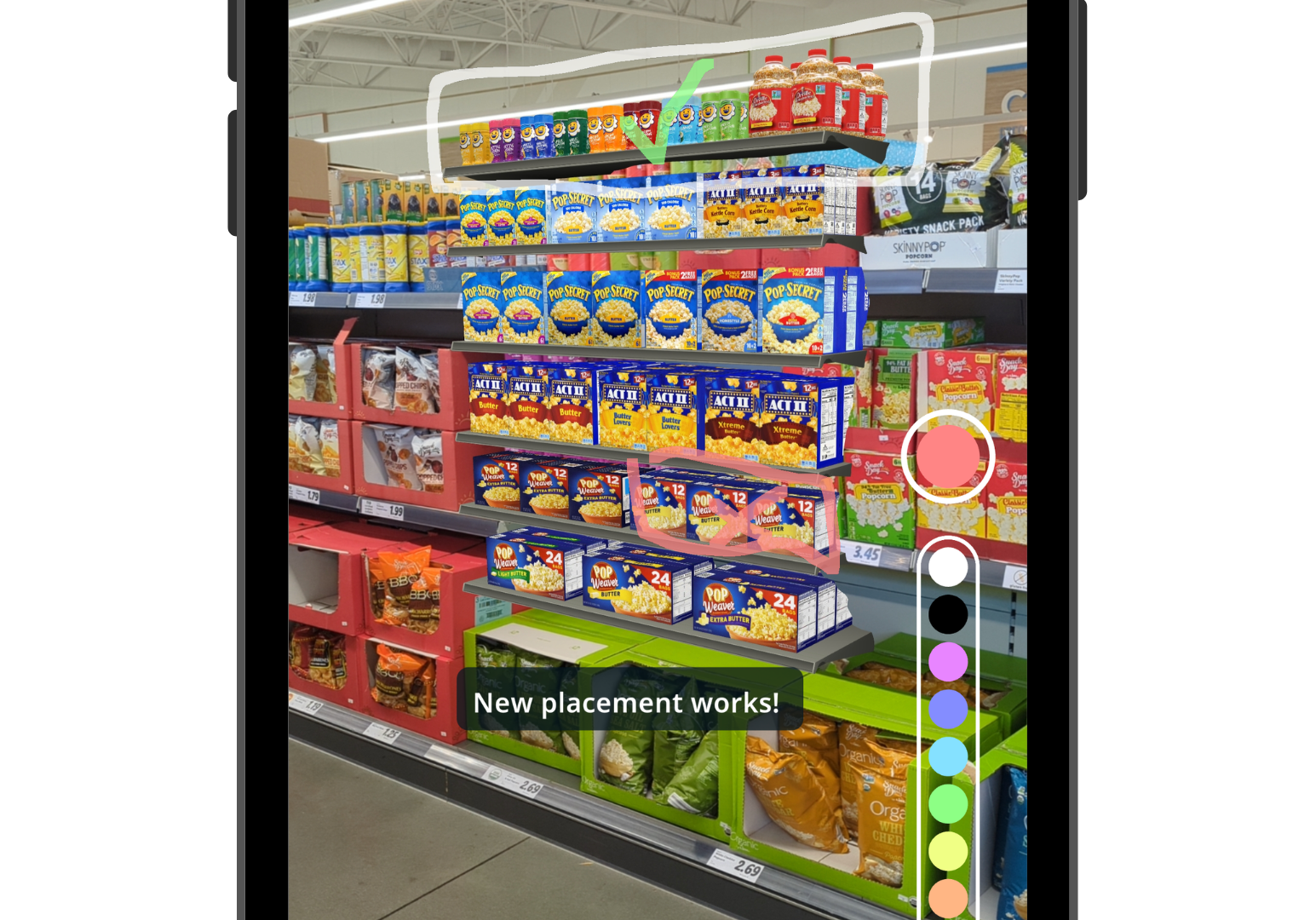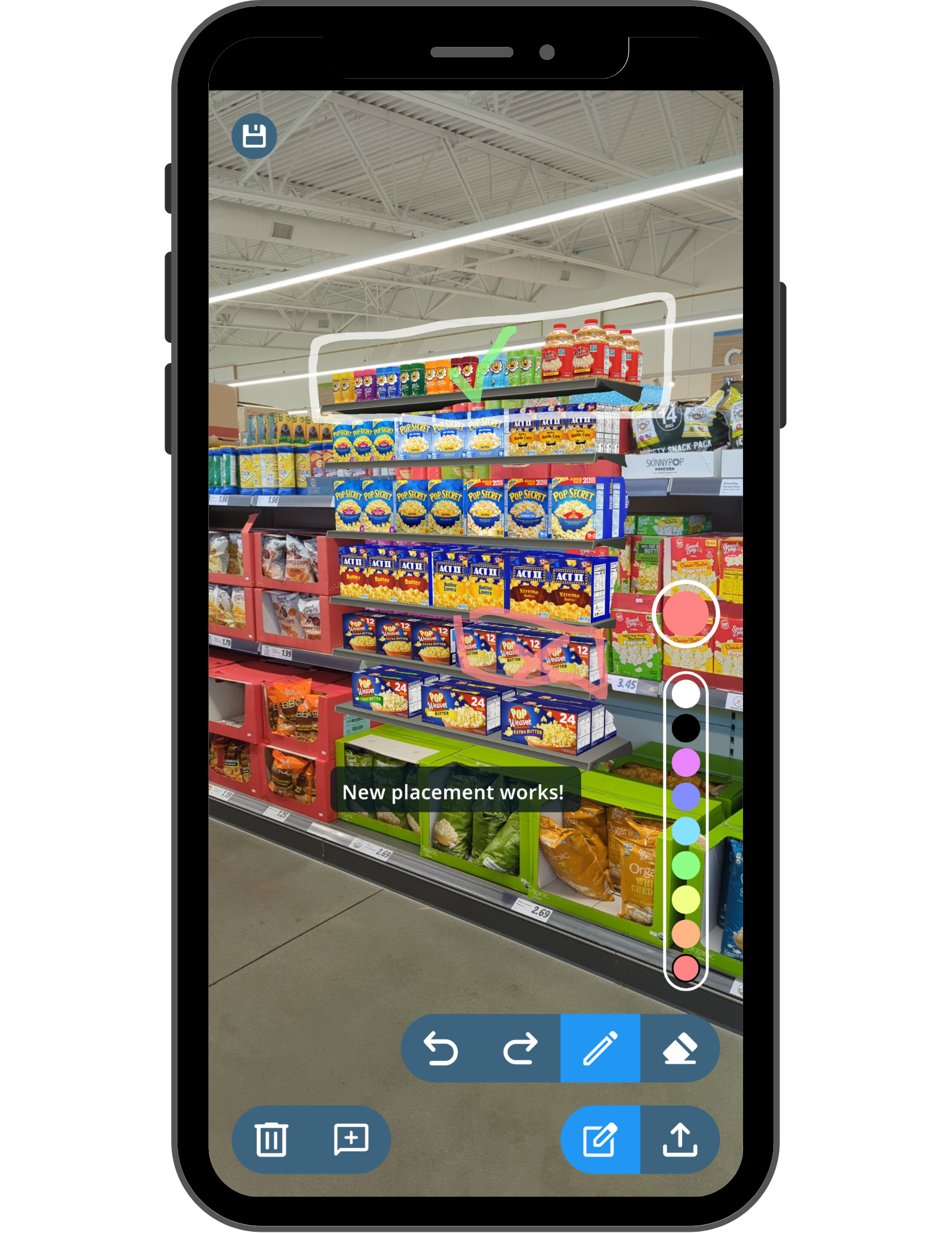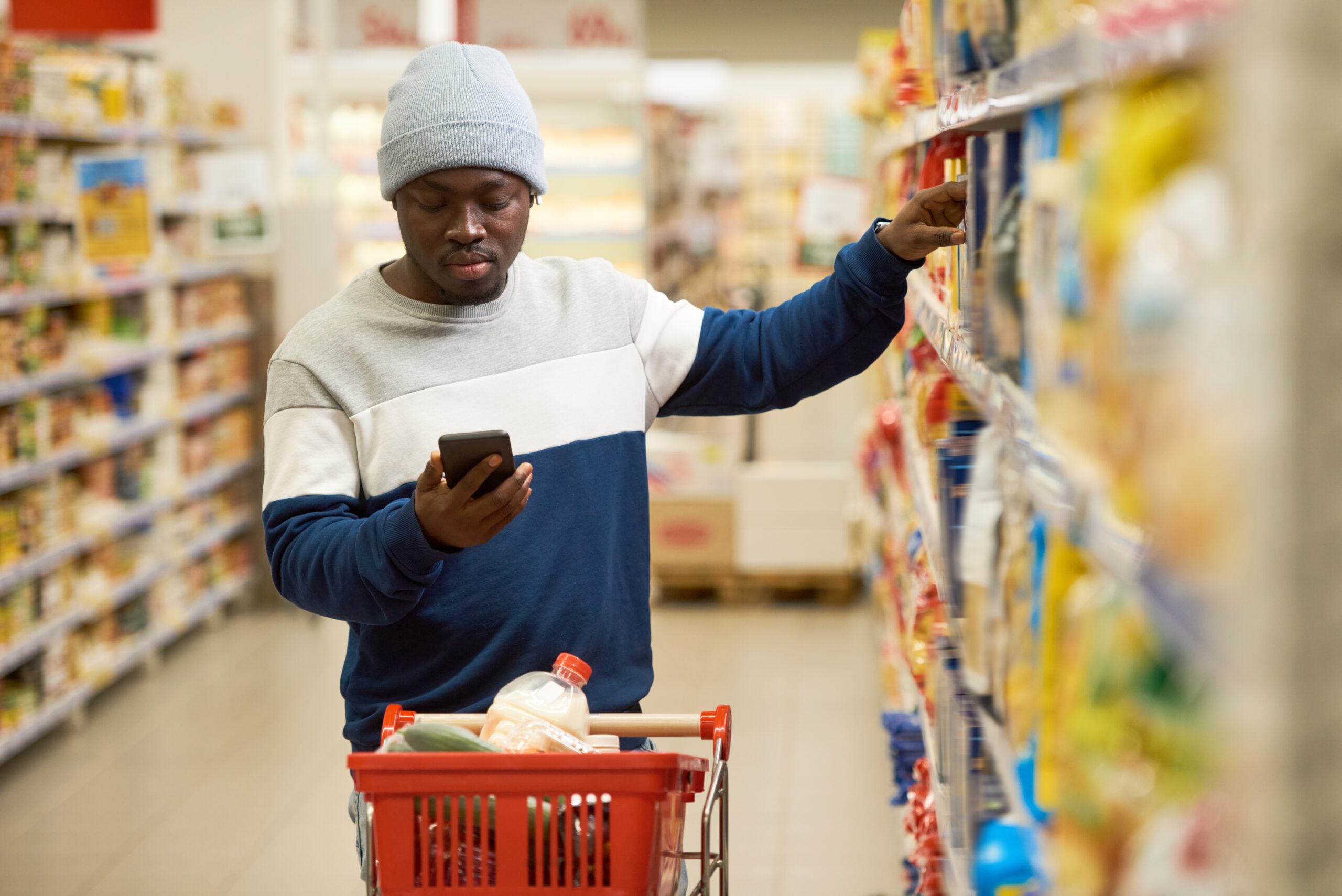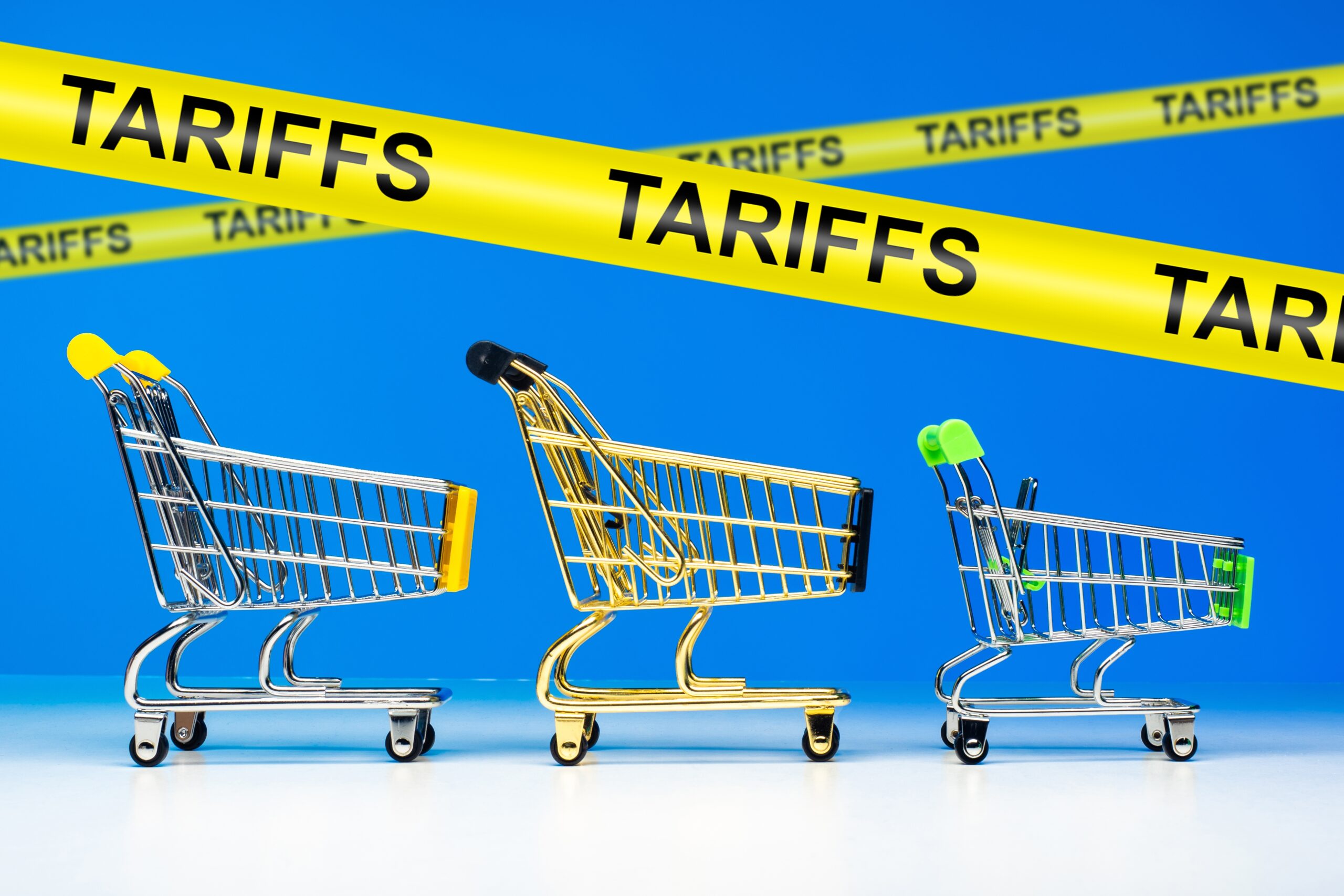Maintaining precise and up-to-date planograms is a paramount challenge for retailers in the dynamic retail realm. These visual representations of shelf and store layouts, detailing the strategic placement of products, are the backbone of efficient merchandising and customer experiences. However, ensuring planogram compliance can often be an intimidating task, as retail spaces are in a constant state of flux. Shelves need restocking, new products are introduced, and customer preferences evolve. Deviations from these planograms can lead to significant operational hiccups, impacting everything from stock management to customer satisfaction.
In this blog post, we delve into the innovative world of augmented reality (AR) and how it offers a transformative solution to the age-old challenge of planogram compliance. We’ll explore how you can leverage AR technology tools and insights that help alleviate planogram compliance issues and drive retail operations to new heights of efficiency and effectiveness.
What is planogram compliance in retail?
When it comes to retail, most shoppers are heavily influenced by what happens within the store’s walls. In fact, according to a recent article by Medium, Maria Georgiou, the Shelf and Assortment Director of Nielsen, stated that “67% of brand decisions are made in-store, which highlights the significant effect that the store, aisle, and shelf have on a shopper’s decision.” So, how do we influence those decisions?
Enter planogram compliance. Planogram compliance refers to a retail store’s adherence to meticulously crafted layouts, known as planograms, which optimize product placement on shelves. These plans dictate product positioning to maximize sales, enhance the customer experience, and streamline inventory management. Compliance measures how accurately the store follows these guidelines, encompassing correct product positioning, alignment with promotional displays, and proper shelf stocking. High compliance maintains visual appeal, minimizes stock issues, and boosts retail efficiency and profitability.
Planograms are vital for the optimization of retail layouts, offering visual blueprints for product organization. These plans consider product categories, customer behavior, and seasonality to ensure optimal product placement. Following planograms results in attractive, well-organized layouts that attract customers, boost sales, and simplify inventory management, underpinning efficient retail spaces.
Benefits of planogram adherence
Planogram adherence offers a multitude of benefits to retailers, ultimately translating into a more streamlined and profitable operation. These benefits include:
Enhanced the customer experience
When products are consistently located where customers expect to find them, shopping becomes more efficient and enjoyable. Customers can easily navigate the store, see what they need quickly, and have a positive impression of its organization. This positive experience often leads to increased customer loyalty.
One compelling example of the benefits of planogram adherence can be seen in the beverage aisle of a grocery store. They follow planograms that place soda brands together and group similar products by type so customers can easily find their preferred beverages without unnecessary searching. This improves the customer experience and increases the likelihood of additional purchases as shoppers encounter complementary items along the way.
Efficient inventory management
Effective inventory management helps prevent overstock and understock situations by ensuring products are stocked according to demand. When retailers consistently follow planograms, they reduce the risk of carrying excess inventory, which can lead to waste and financial losses. Conversely, they can also avoid understocking popular items, which can frustrate customers and result in missed sales opportunities.
Planogram adherence is not just a visual merchandising strategy; it’s a powerful tool that enhances the customer experience, drives sales, and optimizes inventory management. It’s a win-win for retailers and customers, providing a more efficient and enjoyable shopping journey while boosting the bottom line.
Pitfalls of planogram deviation
Planogram deviation can have detrimental consequences for retailers, leading to confusion, decreased customer satisfaction, and lost revenue.
Customer confusion
When products are not positioned per the planogram, it creates a disorganized shopping experience. Customers may struggle to find needed items, leading to frustration and potentially driving them away. For instance, if a planogram calls for placing breakfast cereals in a specific aisle, but they are scattered throughout the store, it can confuse shoppers and hinder their shopping efficiency.
Decreased customer satisfaction
Planogram deviation can also result in decreased customer satisfaction. Inconsistent product placement can disrupt the shopping journey, causing inconvenience and a negative perception of the store’s organization. If a customer expects to find household cleaning supplies in one aisle based on the planogram but discovers them scattered across different sections, it disrupts their shopping flow and can diminish their overall satisfaction.
Loss of revenue
Perhaps the most significant impact of planogram deviation is the potential loss of revenue. When products are not positioned per the planogram’s instructions, it can lead to missed sales opportunities. For example, if a store fails to place seasonal items prominently during the appropriate time, customers may overlook them, resulting in lost sales. Inconsistent stocking can also lead to overstocking and understocking issues, potentially resulting in wasted inventory or missed sales.
How Augmented Reality Transforms Compliance
Augmented Reality (AR) technology represents a cutting-edge fusion of the digital and physical worlds, and its applications in the retail sector are nothing short of transformative. At its core, AR seamlessly overlays digital content, whether 3D models, images, or information, onto the physical world, as users perceive through their devices, such as smartphones or AR glasses. This blending of realities enriches users’ perception of their surroundings by introducing an interactive layer of information and engagement. As consumers view the world through AR-enabled devices, they can witness computer-generated elements coexisting with physical objects, enhancing their understanding and interaction with the environment.
In the realm of retail, AR holds immense promise. It revolutionizes how consumers navigate stores, access product information, and make purchase decisions. From assisting in in-store navigation guiding shoppers to their desired products, to offering immersive visualizations of how furniture or home decor might fit into their living spaces, AR elevates the retail experience to new heights. One notable application is its ability to transform planogram compliance, ensuring that products are displayed on store shelves precisely as visual merchandisers intend. By superimposing digital representations of the ideal product placements onto the real-world store environment, AR empowers retailers to maintain visual consistency, optimize product positioning, and ultimately enhance the overall shopping experience, making it a game-changer for customers and businesses in the retail sector.
It provides:
Visual guidance: AR provides visual cues and overlays that guide store associates in placing products precisely where they should be on shelves, reducing human error.
Real-time feedback: AR systems can offer real-time feedback on the accuracy of product placements, ensuring that planograms are followed correctly during the stocking process.
Training and onboarding: AR can be used for employee training and onboarding, helping new staff members understand planograms quickly and effectively.
Planogram testing: AR allows retailers to test and visualize different planogram configurations virtually before physically rearranging shelves, saving time and resources.
Planogram updates: When planograms change, AR can instantly update digital overlays to reflect the new placement guidelines, ensuring compliance across all stores.
Inventory management: AR can assist inventory management by tracking product levels and alerting staff when restocking is required, ensuring that shelves remain compliant.
Planogram auditing: AR-equipped devices can compare the actual store layout with the intended planogram to identify discrepancies.
Customized planograms: AR can tailor planograms for specific store layouts, considering unique spatial constraints and customer flow patterns.
Reduced training costs: With AR, the need for extensive training materials and printed planograms can be reduced, leading to cost savings and environmental benefits.
Enhanced planogram visualization: AR can make planograms more interactive and visually appealing, helping retailers better communicate their merchandising strategies to store associates.
Improved customer experience: Ultimately, planogram compliance driven by AR leads to a more organized, visually appealing store layout, enhancing the overall shopping experience for customers.
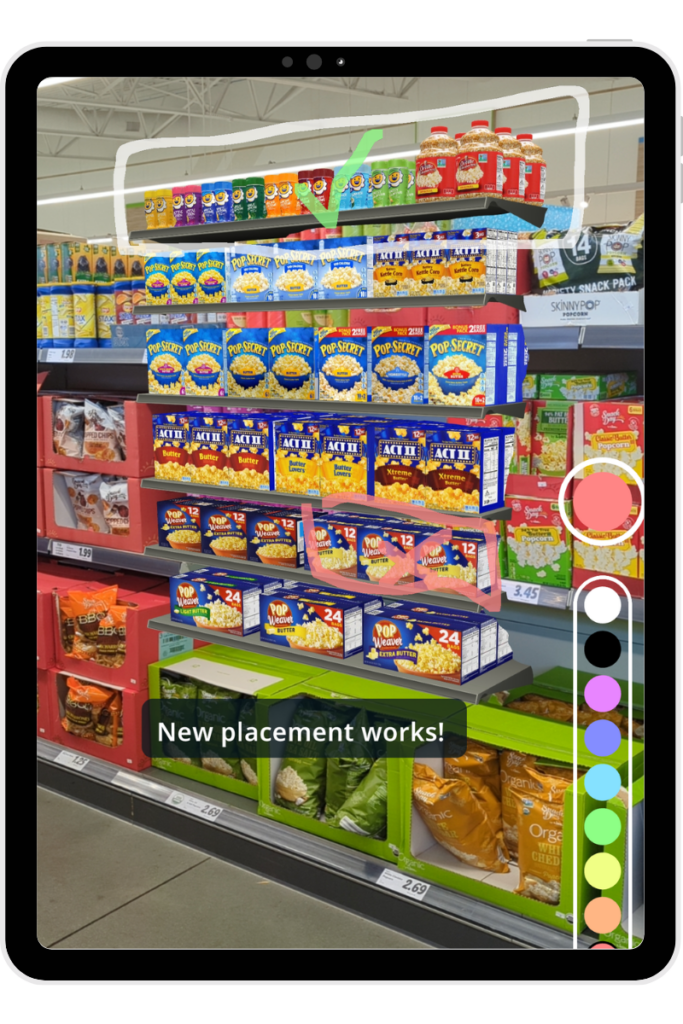 ShopperMX GO: An unparalleled AR tool
ShopperMX GO: An unparalleled AR tool
When it comes to AR tools in retail, InContext’s ShopperMX GO is leading the way in AR planogramming solutions. InContext’s augmented reality field enablement app represents a cutting-edge solution for visualizing and validating displays and signage on-site. This powerful AR technology allows retailers to fast-track the sell-in process by facilitating seamless collaboration and sharing points of interruption within the store environment. Powered by InContext’s industry-leading 3D product assets, SMX GO revolutionizes how retailers plan, execute, and optimize their in-store merchandising strategies, ultimately enhancing the customer shopping experience.
Not only does it help alleviate planogram errors, but it can also:
Grow store-level revenue
Shopper MX GO is pivotal in boosting store-level revenue by leveraging augmented reality capabilities. By overlaying 3D images in real-time, SMX GO enables retailers to swiftly and accurately visualize points of interruption directly within the store premises, all from a mobile device. This powerful tool empowers businesses to identify and overcome obstacles hindering sales with remarkable speed and efficiency, making it easier for retailers to make decisions that ultimately drive revenue growth.
Increase field rep effectiveness
Shopper MX GO benefits retailers in terms of revenue and plays a crucial role in enhancing field rep satisfaction. For sales representatives who may have been relying on static, stand-alone images to present display and marketing concepts, the introduction of augmented reality with SMX GO represents a game-changing improvement. The ease of use and the ability to engage buyers with dynamic 3D visualizations significantly elevate the effectiveness of their sales pitches. This shift towards more interactive and immersive presentations makes their job easier. It boosts their confidence and satisfaction as they witness increased buyer engagement and success in selling display and marketing ideas.
Help you stand out from the competition
Shopper MX GO gives you the competitive advantage you need in the retail landscape. Augmented reality offers a proven and highly impactful means of demonstrating how your concepts will come to life in a retail store. With our cutting-edge 3D visualizations, you can convey your ideas with immediate clarity and comprehension, setting you apart from the competition. This level of engagement and visual communication is unparalleled in sales tools, making SMX GO an indispensable asset for those seeking to stand out and leave a lasting impression in the retail industry.
Partner with InContext to Transform Your Business
Planogram compliance is undeniably a crucial element of retail execution, directly impacting the visual appeal of stores and the overall shopping experience. Ensuring that products are correctly placed on shelves is not merely about aesthetics; it’s about enhancing customer satisfaction, maximizing sales, and optimizing shelf space. Augmented reality technology emerges as a powerful solution to tackle planogram compliance challenges head-on, offering automation and efficiency in-store planogram management.
AR enables retailers to superimpose digital representations of the ideal product placements onto the physical store environment, thus ensuring effective planogram execution. Doing so effectively addresses issues such as out-of-stock instances and non-compliance. Store managers can leverage AR to ensure the right products are in place, improving on-shelf availability and enhancing execution. This transformative technology enhances store operations and fosters a more customer-centric retail environment, ultimately increasing point-of-sale transactions and customer loyalty. AR solutions like InContext’s offerings pave the way for better planogram compliance, reduced operational errors, and faster growth in the competitive world of retail products. Contact us to learn more.
